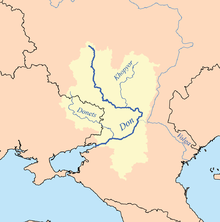Donbas operation (1919)
| Donbas operation of 1919 | |||||||
|---|---|---|---|---|---|---|---|
| Part of the Southern Front of the Russian Civil War | |||||||
 Reproduction of Vasil Vasilovich Zhuravlov's painting Zvilnennya Donbassu from 1919 | |||||||
| |||||||
| Belligerents | |||||||
|
|
| ||||||
| Commanders and leaders | |||||||
|
|
| ||||||
| Units involved | |||||||
|
|
| ||||||
| Strength | |||||||
| unknown | unknown | ||||||
| Casualties and losses | |||||||
|
8,000 men, 24 guns, 170 machine guns, 5 armored trains | 3,000 men | ||||||
The Donbas operation of 1919 was a military campaign of the Russian Civil War between December 18–31, 1919, in which the Southern Front of the Red Army conquered the Donbas region from the Volunteer Army and part of the Don Army.
Prelude[]
After the successful Khopyor–Don operation (November 20–December 8, 1919), the troops of the Red Army on December 16, 1919, entered the Kupiansk-Svatove-Bilolutsk area. In order to prevent the Red Army from crossing the Donets River, the White Guard command began to concentrate a strong force in the area where the crossing was thought to take place. The force consisted of
- the 4th Don Division (General Pavlov),
- the 2nd Kuban Division (General Segei Ulagay)
- the 3rd Kuban Division
- the Cavalry Corps of General Andrei Shkuro,
- the 3rd Cavalry Division of General Chesnokov.
The operation[]

The Red Army plan of attack was as follows. The main attack to this group was to be conducted by the 1st Cavalry Army under command of Semen Budyonniy, from the direction of Popasna Station, Debaltseve and Ilovaisk. Another part of the Red Army forces was to advance on Taganrog, thus not only to defeat the Volunteer Army, but also to prevent its withdrawal to the Don Region. Secondary strikes were to be executed by the 13th Army (commander A.Gekker) in the direction of the cities of Lyov and Yuzovka (now Donetsk) and by the 8th Army (commander G.Sokolnikov) towards Lugansk (Luhansk).
On December 18, the Red Army launched its offensive: 1st Cavalry Army crossed the Donets River during the night of December 23. The White Guard command concentrated a new group in the area of Bakhmut–Popasna, with the task of pushing the 1st Cavalry Army back over the Donets River and then going on the defensive. However, on December 25, the 1st Cavalry army again attacked. On December 27, the Red Army troops captured Lugansk, Bakhmut on the 28th, Debaltsevo on the 29th, and Gorlovka (Horlivka), where the White Guards tried in vain to hold their ground, on the 30th.
Consequences[]
On January 1, 1920, the White Guards were also chased out of Ilovaisk, Amvrosiivka, Rovenky, and Diakove.
Having suffered serious losses (3,000 killed and 5,000 prisoners), the White Guard troops gradually retreated to the Crimea and, partly, to Rostov-on-Don.
Sources[]
- Link O. Y. Shchus. "Donbaska operatsiia" (Donbas operation) // Encyclopedia of the history of Ukraine: T. 2: GD / Redcorn: VA Smoly (head) and others. National Academy of Sciences of Ukraine. Institute of History of Ukraine. - K.: Naukova Dumka, 2004 - 688 pp .
- Battles of the Russian Civil War
- Conflicts in 1919